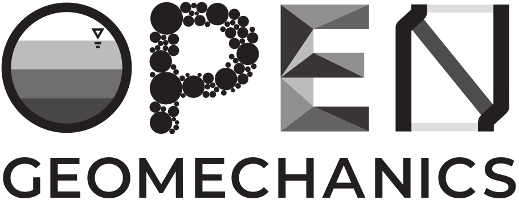Drying induced shrinkage is often attributed to two major mechanisms- capillary pressure in the bulk pore solution and disjoining pressure in the liquid film separating the vapor phase from the pore wall or separating solid surfaces in nanometric pores. There is sufficient ambiguity in literature regarding the relative contribution of these two mechanisms, as well as the means to quantify their contributions. The objective of this manuscript is to evaluate the contribution of disjoining pressure in the drying shrinkage of cementitious materials. An unconventional approach to determining disjoining pressure within the framework of continuum mechanics is presented. This approach utilizes the conservation of linear momentum to derive a generalized expression of the disjoining pressure from the Lorentz force vector. The expression suggests that disjoining pressure is essentially an osmotic pressure at the contact surfaces that counters the electrostatic contribution to linear momentum. The proposed theory accurately predicts measurements of osmotic pressure found in the literature for the swelling of charged bilayers in a dilute salt solution. Applied to the shrinkage problem, the theory suggests that shrinkage stress is induced by the reduction in the potential gradient between the liquid film and bulk solution from the reference (fully saturated) state. The reduction in the potential gradient is caused by an increase in the concentration of the solutes in the pore solution when liquid water is removed as the relative humidity decreases.
Revised:
Accepted:
Published online:
 CC-BY-NC-SA 4.0
CC-BY-NC-SA 4.0
@article{OGEO_2023__4__A1_0,
author = {Rahman, Syeda and Grasley, Zachary},
title = {The role of disjoining pressure on the drying shrinkage of cementitious materials},
journal = {Open Geomechanics},
eid = {2},
pages = {1--12},
year = {2023},
publisher = {Alert Geomaterials},
volume = {4},
doi = {10.5802/ogeo.14},
language = {en},
url = {https://opengeomechanics.centre-mersenne.org/articles/10.5802/ogeo.14/}
}
TY - JOUR AU - Rahman, Syeda AU - Grasley, Zachary TI - The role of disjoining pressure on the drying shrinkage of cementitious materials JO - Open Geomechanics PY - 2023 SP - 1 EP - 12 VL - 4 PB - Alert Geomaterials UR - https://opengeomechanics.centre-mersenne.org/articles/10.5802/ogeo.14/ DO - 10.5802/ogeo.14 LA - en ID - OGEO_2023__4__A1_0 ER -
%0 Journal Article %A Rahman, Syeda %A Grasley, Zachary %T The role of disjoining pressure on the drying shrinkage of cementitious materials %J Open Geomechanics %D 2023 %P 1-12 %V 4 %I Alert Geomaterials %U https://opengeomechanics.centre-mersenne.org/articles/10.5802/ogeo.14/ %R 10.5802/ogeo.14 %G en %F OGEO_2023__4__A1_0
Rahman, Syeda; Grasley, Zachary. The role of disjoining pressure on the drying shrinkage of cementitious materials. Open Geomechanics, Volume 4 (2023), article no. 2, 12 p.. doi: 10.5802/ogeo.14
[1] Double-layer repulsive force between two inclined platy particles according to the Gouy-Chapman theory, Journal of Colloid And Interface Science, Volume 168 (1994) no. 1, pp. 111-117 | DOI
[2] Exact solution of the unidimensional Poisson-Boltzmann equation for a 1:2 (2:1) electrolyte, Biophysical Journal, Volume 16 (1976) no. 9, pp. 1121-1124 | DOI
[3] Numerical solution of the Nernst-Planck and poisson equation system with applications to membrane electrochemistry and solid state physics, Journal of Electroanalytical Chemistry and Interfacial Electrochemistry, Volume 90 (1978) no. 1, pp. 1-31 | DOI
[4] Measurement of Critical Disjoining Pressure for Dewetting of Solid Surfaces, Journal of Colloid and Interface Science, Volume 181 (1996) no. 2, pp. 443-455 | DOI
[5] Poisson-Boltzmann model of electrolytes containing uniformly charged spherical nanoparticles, The Journal of Chemical Physics, Volume 145 (2016) no. 23 | DOI
[6] Role of disjoining pressure in cement based materials, Cement and Concrete Research, Volume 35 (2005) no. 12, pp. 2364-2370 | DOI
[7] Disjoining Pressure of Thin Nonfreezing Water Interlayers between Ice and Silica Surface, Langmuir, Volume 10 (1994) no. 11, pp. 4203-4208 | DOI
[8] Measurement of repulsive forces between charged phospholipid bilayers, Biochemistry (Easton), Volume 17 (1978) no. 15, pp. 3163-3168 | DOI
[9] A Contribution to the Theory of Electrocapillarity, London, Edinburgh and Dublin Philosophical Magazine and Journal of Science, Volume 25 (1913) no. 148, p. 475 | DOI | Zbl
[10] Capillary condensation in systems of immiscible liquids, Journal of Colloid and Interface Science1, Volume 104 (1985) no. 1, pp. 234-249 | DOI
[11] Adhesion between surfaces in undersaturated vapors—a reexamination of the influence of meniscus curvature and surface forces, Journal of Colloid and Interface Science1, Volume 121 (1988) no. 1, pp. 170-178 | DOI
[12] Spreading of nanofluids driven by the structural disjoining pressure gradient, Journal of Colloid and Interface Science, Volume 280 (2004) no. 1, pp. 192-201 | DOI
[13] Electrostatics and excess of osmotic pressure, Mechanics and Physics of Porous Solids, John Wiley & Sons Ltd, West Sussex, 2010, pp. 25-32
[14] Mechanics and Physics of Porous Solids, John Wiley & Sons Ltd, 2010 | DOI
[15] The disjoining pressure, Mechanics and Physics of Porous Solids, John Wiley & Sons Ltd, West Sussex, 2010, pp. 128-131
[16] Disjoining pressure and capillarity in the constrained vapor bubble heat transfer system, Advances in Colloid and Interface Science, Volume 168 (2011) no. 1, pp. 40-49 | DOI
[17] Electrolytes in narrow pores / Electrolyten in engen Poren, Restoration of Buildings and Monuments, Volume 6 (2000) no. 1, pp. 87-102 | DOI
[18] On the question of determining the concept of disjoining pressure and its role in the equilibrium and flow of thin films, Journal of Colloid and Interface Science, Volume 66 (1978) no. 3, pp. 389-398 https://www.sciencedirect.com/science/article/pii/0021979778900565 | DOI
[19] Surface forces, Consultants Bureau, New York, 1987 | DOI
[20] Properties of thin liquid layers, Izv. Akad. Nauk SSSR, Ser. Khim., Volume 5 (1936) no. 5, p. 741
[21] No Title, Izv. Akad. Nauk SSSR, Ser. Khim., Volume 5 (1937), p. 1119
[22] Anomalous Properties of Thin Polymolecular Films V, Acta Physicochim. URSS, Volume 10 (1939) no. 25
[23] Theory of the stability of strongly charged lyophobic sols and of the adhesion of strongly charged particles in solutions of electrolytes, Progress in Surface Science, Volume 43 (1941), pp. 30-59 | DOI
[24] Theory of the stability of strongly charged lyophobic sols and of the adhesion of strongly charged particles in solutions of electrolytes, Progress In Surface Science, Volume 43 (1993), pp. 30-59 | DOI
[25] Anomalien dunner Flussig- keitsschichten III, Acta Physicochim. URSS, Volume 5 (1936) no. 1
[26] Direct measurement of colloidal forces using an atomic force microscope, Nature, Volume 353 (1991) no. 6341, pp. 239-241 | DOI
[27] Osmotic pressure and salt exclusion in electrostatically swollen lamellar phases, The Journal of chemical physics, Volume 96 (1992) no. 3, pp. 2278-2286 | DOI
[28] Modelling the drying shrinkage of porous materials by considering both capillary and adsorption effects, Journal of the mechanics and physics of solids, Volume 142 (2020), 104016 | MR | DOI
[29] Capillary condensation in systems of immiscible liquids, Nat1ure, Volume 290 (1981) no. 5807, pp. 575-576
[30] Direct measurement of the effect of meniscus forces on adhesion: A study of the applicability of macroscopic thermodynamics to microscopic liquid interfaces, Colloids and Surfaces, Volume 3 (1981) no. 4, pp. 303-319 | DOI
[31] Experimental studies on the applicability of the Kelvin equation to highly curved concave menisci, Journal of Colloid and Interface Science, Volume 80 (1981) no. 2, pp. 528-541 | DOI
[32] On the equilibrium of heterogeneous substances, American Journal of Science, Volume s3-16 (1878) no. 96, pp. 441-458 https://www.ajsonline.org/content/s3-16/96/441 | arXiv | DOI | Zbl
[33] Desiccation shrinkage of cementitious materials as an aging, poroviscoelastic response, Cement and Concrete Research, Volume 41 (2011) no. 1, pp. 77-89 | DOI
[34] Adsorption-induced deformation of mesoporous solids, Langmuir, Volume 26 (2010) no. 16, pp. 13021-13027 | DOI
[35] Membrane Transport Characteristics of Ultrafine Capillaries, The Journal of Chemical Physics, Volume 49 (1968) no. 1, pp. 228-234 | DOI
[36] Sur la constitution de la charge électrique à la surface d’un électrolyte, J. Phys. Theor. Appl., Volume 9 (1910) no. 1, pp. 457-468 | Zbl | DOI
[37] Diffuse Double Layer Theory for Electrolytes of Unsymmetrical Valence Types, The Journal of Chemical Physics, Volume 21 (1953) no. 6, pp. 1054-1060 | DOI
[38] The effect of surface and hydrodynamic forces on the shape of a fluid drop approaching a solid surface, Journal of Physics: Condensed Matter, Volume 8 (1996) no. 47, p. 9483 | DOI
[39] Double-layer and solvation forces measured in a molten salt and its mixtures with water, The Journal of Physical Chemistry, Volume 92 (1988) no. 12, pp. 3531-3537 | DOI
[40] Molecular dynamics simulations of disjoining pressure effect in ultra-thin water film on a metal surface, Applied Physics Letters, Volume 103 (2013) no. 26, 263110 | DOI
[41] Measurement of forces between two mica surfaces in aqueous electrolyte solutions in the range 0–100 nm, Journal of the Chemical Society, Faraday Transactions 1: Physical Chemistry in Condensed Phases, Volume 74 (1978), p. 975 (0300-9599) | DOI
[42] Chapter 14 - Electrostatic Forces between Surfaces in Liquids, Intermolecular and Surface Forces, Academic Press, San Diego, 2011, pp. 291-340 | DOI
[43] Refinements to colloid model of C-S-H in cement: CM-II, Cement and Concrete Research, Volume 38 (2008) no. 3, pp. 275-289 | DOI
[44] Onset of Cohesion in Cement Paste, Langmuir, Volume 20 (2004) no. 16, pp. 6702-6709 | DOI
[45] Influence of the Disjoining Pressure on the Equilibrium Interfacial Profile in Transition Zone Between a Thin Film and a Capillary Meniscus, Colloids and Interface Science Communications, Volume 1 (2014), pp. 18-22 | DOI
[46] A theoretical and experimental study of forces between charged mica surfaces in aqueous CaCl2 solutions, The Journal of Chemical Physics, Volume 92 (1990) no. 7, pp. 4399-4407 | DOI
[47] Influence of interfacial rheology on foam and emulsion properties, Advances in Colloid and Interface Science, Volume 88 (2000) no. 1, pp. 209-222 | DOI
[48] Traité de Mécanique Céleste, 4, Imprimerie de Crapelet, 1805, 79 pages
[49] The law of physico-chemical change, Proceedings of the American Academy of Arts and Sciences, Volume 37 (1901) no. 3, pp. 49-69 | Zbl | DOI
[50] Surface charge density and electrokinetic potential of highly charged minerals: Experiments and Monte Carlo simulations on calcium silicate hydrate, Journal of Physical Chemistry B, Volume 110 (2006) no. 18, pp. 9219-9230 | DOI
[51] CHAPTER I - ELECTROSTATICS OF CONDUCTORS, Electrodynamics of Continuous Media (Second Edition) (LANDAU, L.D.; LIFSHITZ, E.M., eds.) (Course of Theoretical Physics), Volume 8, Pergamon, Amsterdam, 1984, pp. 1-33 https://www.sciencedirect.com/science/article/pii/B9780080302751500072 | DOI
[52] Application of disjoining and capillary pressure to liquid lubricant films in magnetic recording, Journal of Applied Physics, Volume 72 (1992) no. 2, pp. 3084-3090 | DOI
[53] A Treatise on Electricity and Magnetism (Third Edition), Dover Publications, Inc., New York, 1954
[54] Densification of C–S–H Measured by 1H NMR Relaxometry, Journal of physical chemistry. C, Volume 117 (2013) no. 1, pp. 403-412 | DOI
[55] Disjoining pressure of thin films on spherical core particles, The Journal of Chemical Physics, Volume 119 (2003) no. 19, pp. 10363-10366 | DOI
[56] Electrostatic potential between surfaces bearing ionizable groups in ionic equilibrium with physiologic saline solution, Journal of Theoretical Biology, Volume 31 (1971) no. 3, pp. 405-428 | DOI
[57] Bridging scales from molecular simulations to classical thermodynamics: density functional theory of capillary condensation in nanopores, Journal of Physics Condensed Matter, Volume 15 (2003), pp. 347-365 | DOI
[58] On the theory of ionic solutions, Biophysical Journal, Volume 15 (1975) no. 2, pp. 143-162 | DOI
[59] DLVO and hydration forces between mica surfaces in Li+, Na+, K+, and Cs+ electrolyte solutions: A correlation of double-layer and hydration forces with surface cation exchange properties, Journal of Colloid and Interface Science, Volume 83 (1981) no. 2, pp. 531-546 | DOI
[60] Hydration forces between mica surfaces in aqueous electrolyte solutions, Journal of Colloid and Interface Science, Volume 80 (1981) no. 1, pp. 153-162 | DOI
[61] The interaction of solid surfaces in aqueous systems, Colloid and Polymer Science, Volume 260 (1982) no. 4, pp. 444-451 | DOI
[62] Surface forces measured between an air bubble and a solid surface in water, Colloids and Surfaces A: Physicochemical and Engineering Aspects, Volume 261 (2005) no. 1, pp. 147-152 | DOI
[63] Bubble-Solid Interactions in Water and Electrolyte Solutions, Langmuir : the ACS journal of surfaces and colloids., Volume 24 (2008) no. 16
[64] Nanoscale Experimental Investigation of Particle Interactions at the Origin of the Cohesion of Cement, Langmuir, Volume 21 (2005) no. 16, pp. 7263-7270 | DOI
[65] Disjoining pressure and thinning transitions in smectic-A liquid crystal films, Physical Review E, Volume 63 (2001) no. 2, 021705 | DOI
[66] Analytical solution of Poisson-Boltzmann equation for interacting plates of arbitrary potentials and same sign, Journal of colloid and interface science, Volume 341 (2010) no. 1, pp. 178-185 | DOI
[67] The effect of cation valency on DLVO and hydration forces between macroscopic sheets of muscovite mica in relation to clay swelling, Colloids and Surfaces, Volume 9 (1984) no. 1, pp. 1-17 | DOI
[68] Statistical mechanics of electrolytes and polyelectrolytes. III. The cylindrical Poisson–Boltzmann equation, The Journal of Chemical Physics, Volume 78 (1983) no. 6, pp. 3223-3232 | DOI
[69] The significance of pore liquid pressure and disjoining pressure on the desiccation shrinkage of cementitious materials, International Journal of Advances in Engineering Sciences and Applied Mathematics, Volume 9 (2017) no. 2, pp. 87-96 | Zbl | MR | DOI
[70] Drying, Shrinkage, and Cracking of Cementitious Materials, Transport in Porous Media, Volume 110 (2015) no. 2, pp. 311-331 | DOI
[71] On the role of structural disjoining pressure and contact line pinning in critical heat flux enhancement during boiling of nanofluids, Applied Physics Letters, Volume 89 (2006) no. 4, 044106 | DOI
[72] Analytical solutions of the Poisson-Boltzmann equation within an interstitial electrical double layer in various geometries, Chemical Physics (2019) | DOI
[73] Influence of surface forces on hydrodynamics of wetting, Colloids and Surfaces A: Physicochemical and Engineering Aspects, Volume 91 (1994), pp. 149-154 | DOI
[74] Disjoining pressure in thin liquid foam and emulsion films - New concepts and perspectives, Journal of Physics Condensed Matter, Volume 15 (2003) no. 27 | DOI
[75] On the equilibrium of vapour at a curved surface of liquid, Philosophical Magazine, Volume 4 (1871), pp. 448-452
[76] Theory of the stability of lyophobic colloids, Journal of Physical and Colloid Chemistry, Volume 51 (1947) no. 3, pp. 631-636 | DOI
[77] Spreading of nanofluids on solids, Nature, Volume 423 (2003), p. 156+ | DOI
[78] An essay on the cohesion of fluids, Philosophical Transactions of the Royal Society of London, Volume 95 (1805), pp. 65-87
[79] Stability of Aqueous Films between Bubbles. Part 1. The Effect of Speed on Bubble Coalescence in Purified Water and Simple Electrolyte Solutions, Langmuir, Volume 26 (2010) no. 11, pp. 8061-8074 | DOI
[80] Capillary condensation under atomic-scale confinement, Nature, Volume 588 (2020) no. 7837, pp. 250-253 | DOI
[81] An exact solution of the nonlinear Poisson-Boltzmann equation in parallel-plate geometry, Colloid and Polymer Science, Volume 296 (2018) no. 11, pp. 1917-1923 | DOI
Cited by Sources:




